22 March 2010
A new submarine landslide at NW Rota, near Guam
The NW Rota volcano is located in the Mariana Volcanic Arc, about 100 km north of Guam at a depth of about 520 below sea level. NSF currently funds an scientific expedition to this active volcano; a scientific cruise to this site is currently occurring. The team are running a blog of their experiences and findings – it is here.
Yesterday they reported that in the time since their 2009 cruise the volcano has experienced a major landslide. The bathymetry data shows this rather well:
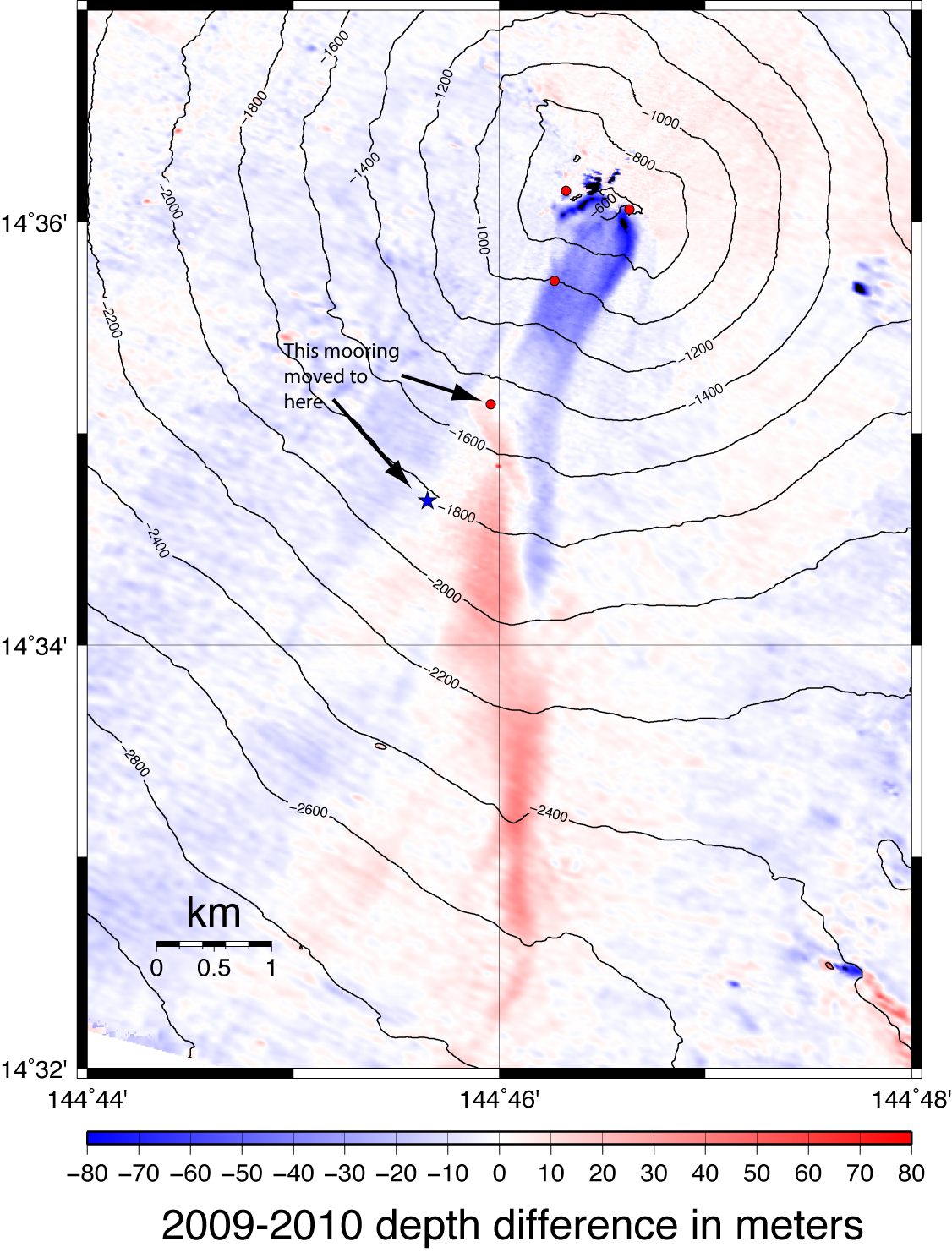 The landslide has caused up to 100 m of erosion from the summit area of the volcano (the blue areas on the map) and up to 40 m of deposition on the gentle lower slopes. These deposits extend for a distance of 8 km.
The landslide has caused up to 100 m of erosion from the summit area of the volcano (the blue areas on the map) and up to 40 m of deposition on the gentle lower slopes. These deposits extend for a distance of 8 km.
20 March 2010
The water level and seepage at the Attabad landslide – graphs of the current situation
Latest update: 25th March 2010 08:00 GMT
I thought it would be useful to post a graph of the current state of play with the water and spillway levels, as I understand it. The water level is from the NDMA daily(ish) updates; the spillway height comes from the freeboard measurement from FOCUS. Needless to say I have no way to validate this data.
Graph as of 23rd March 2010 (the last day for which I have data):
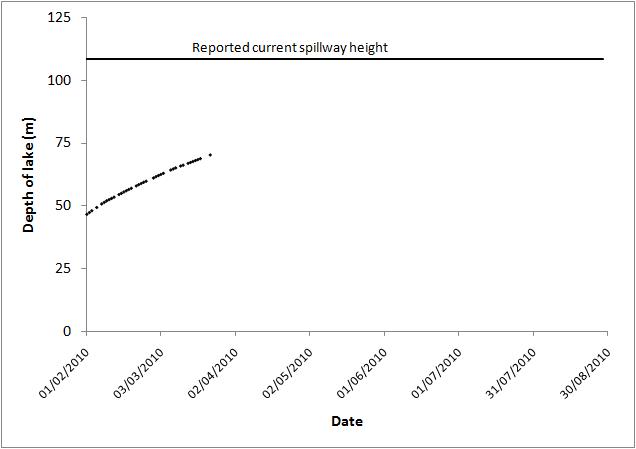
The graph starts on 1st February as this is when the NDMA data starts. Be very careful deriving a date upon which the lake will reach the spillway from this data as the spillway height is somewhat nebulous (can anyone give a definitive height?), it is of course being lowered, the rate of filling may change as snowmelt arrives, etc.
The graph of reported seepage rate is as follows:
11 March 2010
The landslide at Attabad has developed seepage
Late last week the landslide at Attabad started to develop some seepage. Over the last few days this has gradually increased in rate and is now measured at about 9.4 cubic feet per second (0.25 cubic metres per second). The Pamir Times has some images of the seepage:
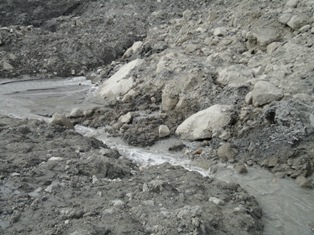 Given this volume of water it is likely that this is flow through the dam, although at the moment this remains unconfirmed. If so, this is a source of real concern as landslide dams sometimes fail through piping. Fortunately, both Focus and NDMA are monitoring this, but there is now a real urgency about getting an evacuation plan in place. This situation could now develop much more rapidly than we had anticipated a week ago.
Given this volume of water it is likely that this is flow through the dam, although at the moment this remains unconfirmed. If so, this is a source of real concern as landslide dams sometimes fail through piping. Fortunately, both Focus and NDMA are monitoring this, but there is now a real urgency about getting an evacuation plan in place. This situation could now develop much more rapidly than we had anticipated a week ago.
Manchester talk on the Sichuan Earthquake disaster
Yesterday I gave a talk to the Manchester branches of the Geographical Association and the Geological Association on the causes of the Sichuan (Wenchuan) earthquake disaster. As usual I promised to make my slides available via Authorstream. You should be able to download the presentation as well as viewing it below.:
10_03 Manchester 1
http://www.authorstream.com/player/player.swf?p=346062_634038962411343750
10 March 2010
Attabad landslide – the Pakistan Government response

Yesterday a meeting was held by the Ministry of the Environment in Islamabad to discuss the Attabad landslide, based at least in part on my report from my recent field visit on behalf of Focus. I am glad to say that the upshot of that meeting is that the authorities are now preparing an evacuation plan for a potential breach of the lake, according to this report:
“As over 15,000 persons are at high risk due to blockade of Hunza river due to an avalanche, Minister for Environment Hamidullah Jan Afridi Tuesday directed authorities to prepare an emergency plan to rescue people prior to releasing the water. At an important meeting held to review the situation after accumulation of water in the Hunza river, the minister asked FWO, NESPAK, NDMA and other authorities to conduct an immediate study of the impact if lake bursts out, and prepare a foolproof plan. “Let us come up with a time-frame and estimated volume of damages if the lake outbursts and also gauge the magnitude of relief we needed thereon,” he asked the participants of the meeting, belonging to key departments like NDMA, NESPAK, SUPARCO, WAP-DA, Ministries of Environment and Interior and the Gilgit-Baltistan government. “Lives of the people are important for us. We need a comprehensive study and plan for expected damages and rescue efforts,” Afridi said, adding that he would seek support from the Chinese government to release water from the Hunza river. The Hunza river was blocked after a two-kilometre wide and 380 feet high avalanche slipped into it at Ata Abad on January 4. Due to this avalanche, the water was blocked and created a 213 feet deep and 11.5 kilometre long lake. The experts briefed the minister that the outburst of this lake would damage vast area and also threaten lives of more than 15,000 people from Hunza down to Gilgit and onwards to NWFP upto Tarbela dam. Ms Khadija from SCOPE in her presentation mentioned that more than 500,000 people would suffer, to minor and major magnitude, if the water is not released and the lake bursts out spontaneously. She also mentioned of the impact downstream Gilgit upto Tarbela and proposed to gradually release the water from the lake ensuring minimum damages. It is worth mentioning that a spontaneous outburst will not only displace thousands of residents but also have a reverse flow impact on Gilgit, Gizer and Skardu rivers like the 1858 floods that had reversed the flow of Kabul river upto 50 kilometres. It will further be aggravating the damages exposing the localities besides these rivers to hazards as well as damaging around 30 kilometre patch of Korakorum Highway. The water level in the lake had risen to 213 feet by Tuesday and was rising by two feet daily. The situation will become more dangerous with increased inflow after melting of snow as temperature usually rises upto four degree centigrade in April.”
It is good to see that the government is responding to the threat posed by this landslide dam.
9 March 2010
Free workshop on coastal erosion, 19th March 2010
We are running a free workshop on erosion on 19th March 2010 in North Yorkshire, UK. Details in the flyer below, together with contact details (click on the image for a better view in a new window).
Please do register to come along!
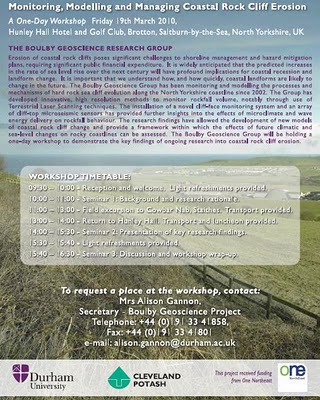
Another life lost at Attabad
Construction of the spillway at Attabad in northern Pakistan continues, but there is little doubt that the construction workers at the site, and indeed those walking over the dam to access the boat service, face considerable risks from rockfalls from the original landslide scar. On 4th March such a rockfall occurred, striking two people on the upslope face of the landslide deposit. One, an army bulldozer driver, was injured whilst the other, a boyscout named Shezad, was unfortunately killed.
The rockfall that caused the incident was captured on video and can be seen below. The event in question starts at about 2 minutes 25 seconds. The final part of the video shows the aftermath of the rockfall as the two victims are brought up to a vehicle to be taken to hospital. Shezad is placed inside the cab, whilst the army worker is placed on the back of the pick-up. By western standards the coverage might be considered to be intrusive:
Meanwhile, the Pakistan government appears to be growing increasingly aware of the very serious threat posed by the landslide. The President of Pakistan, Asif Ali Zardari, yesterday expressed concern about the situation in terms of the provision of relief and on the construction of the spillway. However, the biggest issue is still the potential flood associated with breaching of the dam. The apparent lack of concern about this is very worrying.
The lake level continues to rise at about 50 cm per day according to the NDMA figures.
5 March 2010
New rockslide video: Highway 96 at Klamath River near the Siskiyou-Humboldt county line
Thanks to Kyle House of the Nevada Bureau of Mines and Geology for bringing this one to my attention.
A great new video was posted yesterday showing a rockslide onto Highway 96 at Klamath River near the Siskiyou-Humboldt county line in California. The video should be embedded below:
http://vimeo.com/moogaloop.swf?clip_id=9836643&server=vimeo.com&show_title=1&show_byline=1&show_portrait=0&color=&fullscreen=1
Rock slide on Hwy 96 in Northern California near the Humboldt/Siskiyou County line. from Paul Hailey on Vimeo.
Well worth a look! More details of the slide here:
http://www.redding.com/news/2010/mar/03/staggering-rock-slide-closes-highway-96-near-humbo/
The Attabad landslide in N. Pakistan – some initial images from my field visit this week
I am now back from my comparatively short but very interesting trip to the Attabad landslide in N. Pakistan. I will make a series of posts about this serious but very interesting landslide over the next few days. As a taster, here a few images of the site. The first image was taken from the top of the 1858 Salmanabad landslide deposit, looking upstream to the Attabad slide. The scar of the landslide is on the left and extends beyond the snowline. The main landslide deposit is on the right, coated with a layer of black clay-silt sediment that was scooped up from the river bed by the slide. In the valley bottom the secondary flow is also visible – this was a mudflow of riverbed sediment that travelled about 1.5 km. Look carefully on the full image (click on the image below to see this) and you will see the ruins of some buildings on the left side of the mudflow, at the junction with the rock cliff. This is the place where the 19 victims of the landslide died, struck by the mudflow:
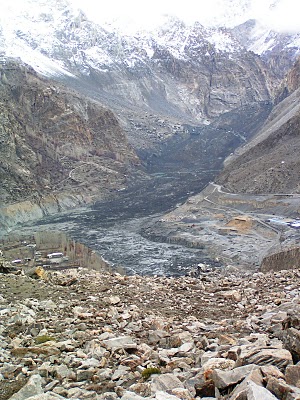 The image below shows the spillway under construction. At the moment the spillway is still being excavated in the black mudflow deposit, although this will shortly break through to the underlying colluvium. The army are optimistic that the spillway will survive the summer flood – others may have a different opinion…
The image below shows the spillway under construction. At the moment the spillway is still being excavated in the black mudflow deposit, although this will shortly break through to the underlying colluvium. The army are optimistic that the spillway will survive the summer flood – others may have a different opinion…
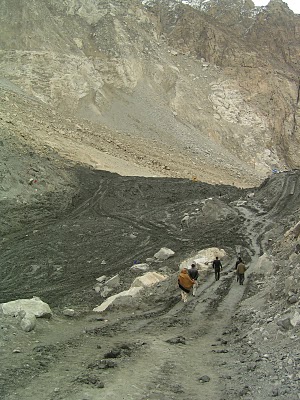 This final image is a view from the top of the landslide deposit looking upstream. In the foreground is the landslide deposit – note the lack of black clay here. In the background is the lake and, beyond that, the rock walls of the main river valley. If the landslide does survive then a new section of the Karakoram Highway will need to be built through this section. This will take some time.
This final image is a view from the top of the landslide deposit looking upstream. In the foreground is the landslide deposit – note the lack of black clay here. In the background is the lake and, beyond that, the rock walls of the main river valley. If the landslide does survive then a new section of the Karakoram Highway will need to be built through this section. This will take some time.
3 March 2010
Landslides in Art Part 5
I apologise for the lack of posts of late. I am currently in Pakistan to visit the Attabad landslide, courtesy of FOCUS Pakistan. I will post on that soon, and of course there has been a great deal happening in the landslide world whilst I have been in the field.
Anyway, this is the latest in my series on landslides in art. The previous parts can be found here:
Part 1
Part 2
Part 3
Part 4 (coastal erosion)
This edition of courtesy of the ever-helpful Sekhar Kuriakose of ITC in the Netherlands.
 The artist in E.J Roychan, an artist from Kerala in India, now living in Saudi Arabia. The piece is called “Urul Pottal”, which means debris flow, in Malayalam. Sekhar describes the genesis of the piece as follows:
The artist in E.J Roychan, an artist from Kerala in India, now living in Saudi Arabia. The piece is called “Urul Pottal”, which means debris flow, in Malayalam. Sekhar describes the genesis of the piece as follows:
“He is a very good friend of mine. He got inspired by my work on landslides and contemplated and created this piece for me.”


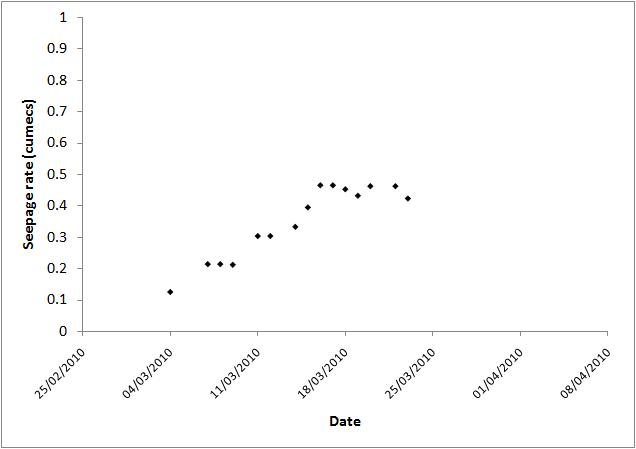
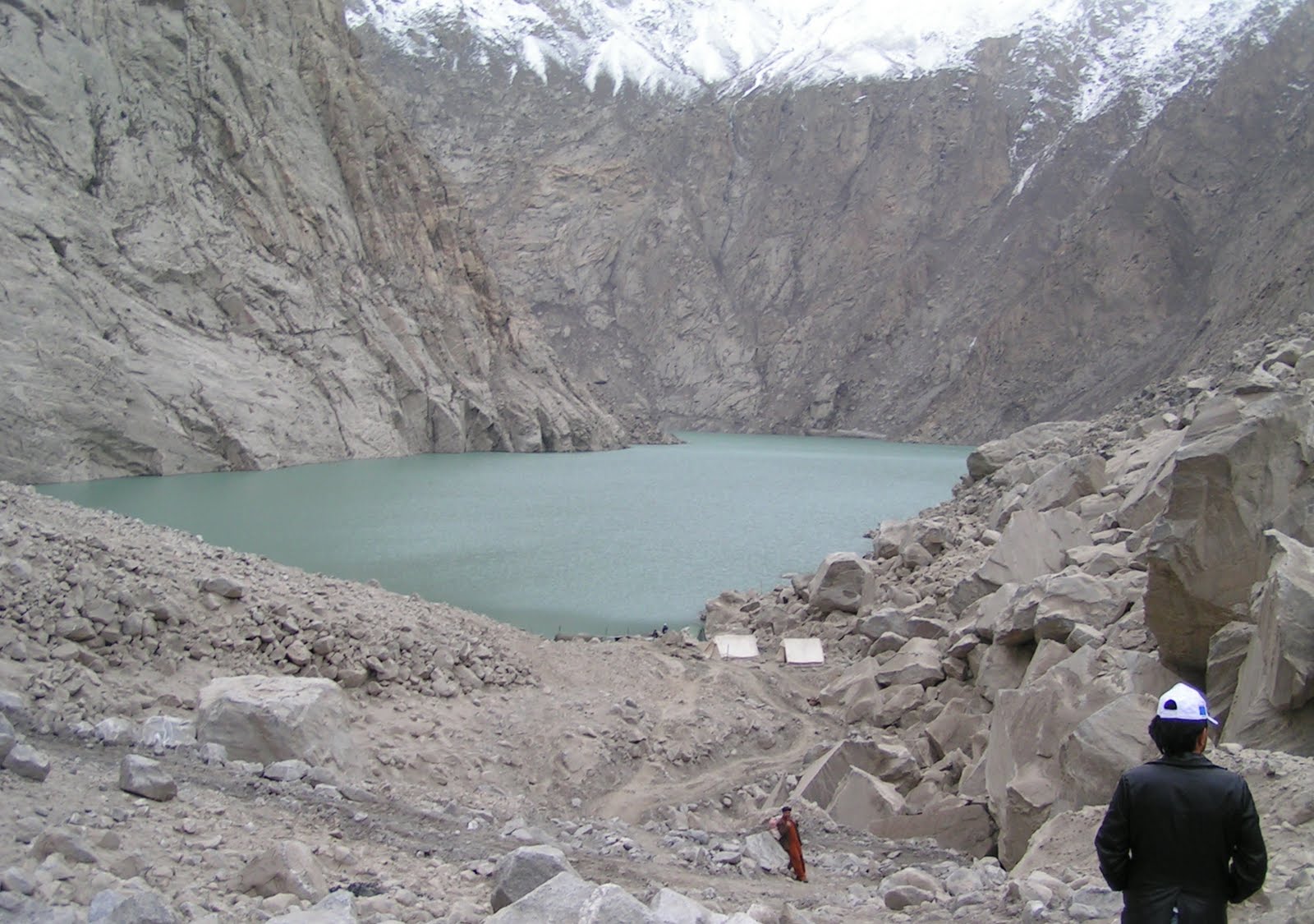
 Dave Petley is the Vice-Chancellor of the University of Hull in the United Kingdom. His blog provides commentary and analysis of landslide events occurring worldwide, including the landslides themselves, latest research, and conferences and meetings.
Dave Petley is the Vice-Chancellor of the University of Hull in the United Kingdom. His blog provides commentary and analysis of landslide events occurring worldwide, including the landslides themselves, latest research, and conferences and meetings.
Recent Comments